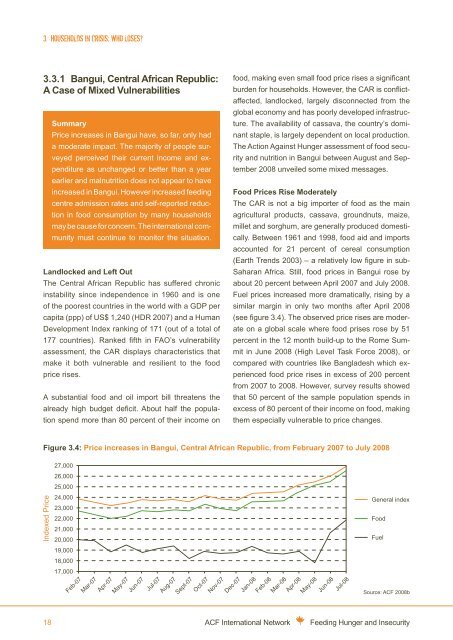Feeding hunger and insecurity
Feeding hunger and insecurity
Feeding hunger and insecurity
- No tags were found...
Create successful ePaper yourself
Turn your PDF publications into a flip-book with our unique Google optimized e-Paper software.
3. households in crisis: who loses?3.3.1 Bangui, Central African Republic:A Case of Mixed VulnerabilitiesSummaryPrice increases in Bangui have, so far, only hada moderate impact. The majority of people surveyedperceived their current income <strong>and</strong> expenditureas unchanged or better than a yearearlier <strong>and</strong> malnutrition does not appear to haveincreased in Bangui. However increased feedingcentre admission rates <strong>and</strong> self-reported reductionin food consumption by many householdsmay be cause for concern. The international communitymust continue to monitor the situation.L<strong>and</strong>locked <strong>and</strong> Left OutThe Central African Republic has suffered chronicinstability since independence in 1960 <strong>and</strong> is oneof the poorest countries in the world with a GDP percapita (ppp) of US$ 1,240 (HDR 2007) <strong>and</strong> a HumanDevelopment Index ranking of 171 (out of a total of177 countries). Ranked fifth in FAO’s vulnerabilityassessment, the CAR displays characteristics thatmake it both vulnerable <strong>and</strong> resilient to the foodprice rises.A substantial food <strong>and</strong> oil import bill threatens thealready high budget deficit. About half the populationspend more than 80 percent of their income onfood, making even small food price rises a significantburden for households. However, the CAR is conflictaffected,l<strong>and</strong>locked, largely disconnected from theglobal economy <strong>and</strong> has poorly developed infrastructure.The availability of cassava, the country’s dominantstaple, is largely dependent on local production.The Action Against Hunger assessment of food security<strong>and</strong> nutrition in Bangui between August <strong>and</strong> September2008 unveiled some mixed messages.Food Prices Rise ModeratelyThe CAR is not a big importer of food as the mainagricultural products, cassava, groundnuts, maize,millet <strong>and</strong> sorghum, are generally produced domestically.Between 1961 <strong>and</strong> 1998, food aid <strong>and</strong> importsaccounted for 21 percent of cereal consumption(Earth Trends 2003) – a relatively low figure in sub-Saharan Africa. Still, food prices in Bangui rose byabout 20 percent between April 2007 <strong>and</strong> July 2008.Fuel prices increased more dramatically, rising by asimilar margin in only two months after April 2008(see figure 3.4). The observed price rises are moderateon a global scale where food prises rose by 51percent in the 12 month build-up to the Rome Summitin June 2008 (High Level Task Force 2008), orcompared with countries like Bangladesh which experiencedfood price rises in excess of 200 percentfrom 2007 to 2008. However, survey results showedthat 50 percent of the sample population spends inexcess of 80 percent of their income on food, makingthem especially vulnerable to price changes.Figure 3.4: Price increases in Bangui, Central African Republic, from February 2007 to July 200827,00026,00025,000Indexed Price24,00023,00022,00021,00020,000General indexFoodFuel19,00018,00017,000Feb-07Mar-07Apr-07May-07Jun-07Jul-07Aug-07Sept-07Oct-07Nov-07Dec-07Jan-08Feb-08Mar-08Apr-08May-08Jun-08Jul-08Source: ACF 2008b18ACF International Network<strong>Feeding</strong> Hunger <strong>and</strong> Insecurity

















